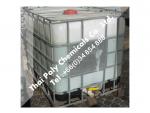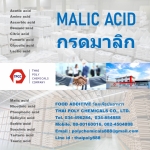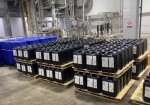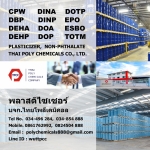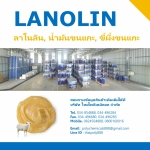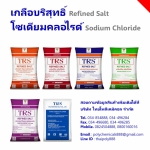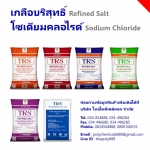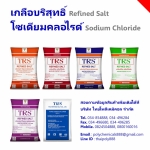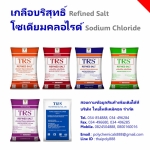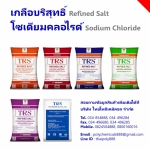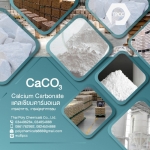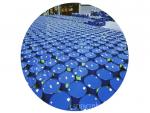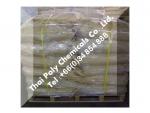Hydrochloric acid กรดไฮโดรคลอริก กรดเกลือ HCl |
฿1 |
|
ชื่อผู้ประกาศ : Thailandchemicals เบอร์โทรศัพท์ : 034854888, 034496284 โทรศัพท์มือถือ : 0824504888, 0800160016 ที่อยู่ : 36/5 ม.9 ต.นาดี อ.เมืองสมุทรสาคร ร้าน Thailand Chemicals |
กรดไฮโดรคลอริก, กรดเกลือ, Hydrochloric acid, HCl
กรดไฮโดรคลอริก หรือ กรดเกลือ (อังกฤษ: hydrochloric acid) เป็นสารประกอบเคมีประเภทกรดละลายในน้ำ โดยเป็นสารละลายของไฮโดรเจนคลอไรด์ (HCl) เป็นกรดแก่, เป็นส่วนประกอบหลักของกรดกระเพาะ (gastric acid) และใช้กันอย่างกว้างในอุตสาหกรรมเป็นของเหลวที่มีพลังการกัดกร่อนสูง
กรดไฮโดรคลอริก
หรือ มูเรียติกแอซิด ถูกค้นพบโดย "จาเบียร์ เฮย์ยัน" (Jabir ibn
Hayyan) ราวปี ค.ศ. 1800 ช่วงปฏิวัติอุตสาหกรรม
(Industrial Revolution) ถูกใช้อย่างกว้างขวางในการผลิตสารประกอบอินทรีย์
เช่น วีนิลคลอไรด์ สำหรับผลิต PVC พลาสติก และ MDI/TDI
(Toluene Diisocyanate) สำหรับผลิต พอลิยูลิเทน,
(polyurethane) และใช้ในการผลิตขนาดเล็กเช่น การผลิต เจนลาติน (gelatin)
ใช้ปรุงอาหาร, และ ใช้ฟอกหนัง
กำลังผลิตในปัจจุบันประมาณ 20 ล้านเมตริกตัน ต่อปี (20
Mt/a) ของก๊าซ HCl
การผลิต
ในการผลิต
กรดไฮโดรคลอริกปริมาณมากๆ จะเกี่ยวข้องกับการผลิตสารประกอบเคมีตัวอื่นๆในเชิงอุตสาหกรรมด้วยในอุตสาหกรรม
กรดเกลือหรือกรดไฮโดรคลอริกเป็นสารประกอบเคมีประเภทกรดละลายในน้ำ
โดยเป็นสารละลายไฮโดรเจนคลอไรด์ในน้ำ
- ถ้าพบในรูปของเหลว เรียกว่า Hydrochloric acid (
กรดเกลือ )
- ถ้ามีสถานะเป็นแก๊ส เรียกว่า
Hydrogen chloride
กรดเกลือเป็นสารที่ไม่มีสี มีกลิ่นฉุน มีฤทธิ์ผุกร่อนอย่างรุนแรง
กรดไฮโดรคลอริก ถูกค้นพบโดย
จาเบียร์ เฮย์ยัน ( Jabir ibn Hayyan
) ถูกใช้อย่างกว้างขวางในการผลิตสารประกอบอินทรีย์ เช่น
ไวนิลคลอไรด์ สำหรับผลิต PVC
พลาสติก และ MDI/TDI (Toluene Dissocyanate ) สำหรับผลิตโพลิยูริเทน ( Polyurethane) และใช้ในการผลิตขนาดเล็ก เช่น
ผลิตเจลาติน ใช้ปรุงอาหาร ใช้ฟอกหนัง
กรดเกลือในห้องปฏิบัติการใช้ในการผลิตสารประกอบคลอไรด์ และใช้ในการแยกแร่ให้บริสุทธิ์ เช่น แร่สังกะสี แทนทาลัม เป็นต้น และมักใช้กรดเกลือ เป็นส่วนประกอบที่สำคัญในผลิตภัณฑ์ประเภทน้ำยาล้างห้องน้ำ
ในร่างกายมนุษย์ ในส่วนของกระเพาะอาหารมีกรดเกลือ
ทำหน้าที่ช่วยในการทำงานของเอ็นไซม์เปบซิน
กรดเกลือ จัดเป็นกรดแก่ เนื่องจากมีความสามารถในการแตกตัวได้ 100 %
สามารถเขียนสมการแสดงการแตกตัวได้ดังนี้ HCl+ H2O ------>
H+ + Cl-
หรือ HCl + H2O H3O+ + Cl-กรดไฮโดรคลอริก
หรือกรดเกลือ เป็นสารประกอบเคมีประเภทกรดละลายในน้ำ โดยเป็นสารละลายของไฮโดรเจนคลอไรด์ เป็นกรดแก่ และใช้กันอย่างกว้างในอุตสาหกรรม กรดเกลือเป็นของเหลวที่มีพลังการกัดกร่อนสูง กรดไฮโดรคลอริก
สารที่มีสูตรโครงสร้างเป็น
HCl
ถ้าพบในรูปของเหลว เรียกว่า Hydrochloric acid (กรดเกลือ) ถ้ามีสถานะเป็นก๊าซ เรียกว่า Hydrogen chloride ถ้าสารนี้เกิดปฏิกิริยา acid-base กับสารที่เป็นด่าง
จะเรียกว่าเป็นเกลือ hydrochloride ของด่างนั้นๆ
ในการผลิตกรดไฮโดรคลอริกปริมาณมากๆ
จะเกี่ยวข้องกับการผลิตสารประกอบเคมีตัวอื่นๆ ในเชิงอุตสาหกรรมด้วย ในอุตสาหกรรมคลอร์-อัลคะไล สารละลายเกลือจะถูกอิเล็กโตรไลซ์ จนได้ผลผลิตออกมาเป็นคลอรีน โซเดียมไฮดรอกไซด์ และก๊าซไฮโดรเจน คลอรีนบริสุทธิ์จะมาผสมกับก๊าซไฮโดรเจนแล้วเกิดเป็นก๊าซไฮโดรเจรคลอไรด์บริสุทธิ์ ก๊าซไฮโดรเจนคลอไรด์บริสุทธิ์ถูกดูดซับลงน้ำ และเข้าสู่ขบวนการเปลี่ยนเป็นกรดเกลือบริสุทธิ์ต่อไป มักพบกรดเกลือในผลิตภัณฑ์ประเภทน้ำยาล้างห้องน้ำ เพราะกรดเกลือจะมีคุณสมบัติในการกัดกร่อนคราบสกปรก ทำให้สามารถทำความสะอาดสุขภัณฑ์ได้ง่าย ผลิตภัณฑ์เหล่านี้มักจะมีกรดเกลือเป็นส่วนผสมอยู่เสมอ กรดมีฤทธิ์กัดกร่อน
Muriatic
acid; Chlorohydric acid; Spirits of salts; Hydrogen chloride (acid); Hydrogen chloride; Hydrogen Chloride Gas only. Hydrochloric acid is a clear, colorless, highly pungent solution of hydrogen chloride (HCl) in water. It is a highly corrosive, strong mineral acid with many industrial uses. Hydrochloric acid is found naturally in gastric acid. Historically called acidum salis, muriatic acid, and spirits of salt, hydrochloric acid was produced from vitriol (sulfuric acid) and common salt. It first appeared during the Renaissance, and then it was used by chemists such as Glauber, Priestley and Davy in their scientific research. With major production starting in the Industrial Revolution, hydrochloric acid is used in the chemical industry as a chemical reagent in the large-scale production of vinyl chloride for PVC plastic, and MDI/TDI for polyurethane. It has numerous smaller-scale applications, including household cleaning, production of gelatin and other food additives, descaling, and leather processing. About 20 million tonnes of hydrochloric acid are
Applications
Hydrochloric
acid is a strong inorganic acid that is used in many industrial processes. The
Pickling
of steel
One
of the most important applications of hydrochloric acid is in the pickling of steel, to remove rust or iron oxide scale from iron or steel before subsequent processing, such as extrusion, rolling, galvanizing, and other techniques. Technical quality HCl at typically 18% concentration is the most commonly used pickling agent for the pickling of
The
spent acid has long been re-used as iron(II) chloride (also known as ferrous chloride) solutions, but high heavy-metal levels in the pickling liquor have
The
steel pickling industry has developed hydrochloric acid regeneration processes, such as the spray roaster or the fluidized bed HCl regeneration process, which allow the recovery of HCl from spent pickling liquor. The most common regeneration process is the pyrohydrolysis process, applying the following
4 FeCl2 + 4 H2O + O2 ? 8 HCl+ 2 Fe2O3
By recuperation of the spent acid, a closed acid loop is established.[17] The iron(III) oxide by-product of the regeneration process is valuable, used in a
Production
of organic compounds
Another
major use of hydrochloric acid is in the production of organic compounds, such as vinyl chloride and dichloroethane for PVC. This is often captive use, consuming locally produced hydrochloric acid that never actually reaches the open market. Other organic compounds produced with hydrochloric acid include bisphenol A for polycarbonate, activated carbon, and ascorbic acid, as well as numerous pharmaceutical products. 2 CH2=CH2 + 4
Production
of inorganic compounds
Numerous
products can be produced with hydrochloric acid in normal acid-base reactions, resulting in inorganic compounds. These include water treatment chemicals such
Both
iron(III) chloride and PAC are used as flocculation and coagulation agents in
Other
inorganic compounds produced with hydrochloric acid include road application salt calcium chloride, nickel(II) chloride for electroplating, and zinc
CaCO3 + 2 HCl ? CaCl2 + CO2 + H2O (calcium chloride
from limestone)pH
Control and neutralization
Hydrochloric
acid can be used to regulate the acidity (pH) of solutions. OH? + HCl ? H2O + Cl?
In
industry demanding purity (food, pharmaceutical, drinking water), high-quality hydrochloric acid is used to control the pH of process water streams. In less-demanding industry, technical quality hydrochloric acid suffices for
Regeneration
of ion exchangers
High-quality
hydrochloric acid is used in the regeneration of ion exchange resins. Cation exchange is widely used to remove ions such as Na+ and Ca2+ from aqueous solutions, producing demineralized water. The acid is used to rinse the cations from the resins. Na+ is replaced with H+ and Ca2+ with 2 H+. Ion exchangers and demineralized water are used in all chemical industries, drinking water
Other
Hydrochloric
acid is used for a large number of small-scale applications, such as leather processing, purification of common salt, household cleaning,[26] and building construction. Oil production may be stimulated by injecting hydrochloric acid into the rock formation of an oil well, dissolving a portion of the rock, and creating a large-pore structure. Oil well acidizing is a common process in the North Sea oil production industry. Hydrochloric acid has been used for dissolving calcium carbonate, i.e. such things as de-scaling kettles and for cleaning mortar off brickwork, but it is a hazardous liquid which must be used with care. It is reported[by whom?] that hydrochloric acid can damage glazes if used for limescale removal; sulphamic should be used in preference.[citation needed] When used on brickwork the reaction with the mortar only continues until the acid has all been converted, producing Calcium Chloride, Carbon Dioxide and water:- 2HCl + CaCO3 = CaCl2 + CO2 + H20. Many chemical reactions involving hydrochloric acid are applied in the production of food, food ingredients, and food additives. Typical products include aspartame, fructose, citric acid, lysine, hydrolyzed vegetable protein as food enhancer, and in gelatin production. Food-grade (extra-pure) hydrochloric acid can be applied
สอบถามข้อมูลเพิ่มเติมได้ที่
ฝ่ายขาย
Thai
Poly Chemicals Co., Ltd.
บริษัท
ไทยโพลีเคมิคอล จำกัด
ที่อยู่36/5
ม.9 แขวง/ตำบลนาดี เขต/อำเภอเมืองสมุทรสาคร จังหวัดสมุทรสาคร รหัสไปรษณีย์74000
Tel.:
034854888, 034496284
Fax.:
034854899, 034496285
Mobile:
0824504888, 0800160016
Website
: www.thaipolychemicals.com
Email1 : thaipolychemicals@hotmail.com
Email2 : info@thaipolychemicals.com
กรดฟอร์มิคHClHydrocloricไฮโดรคลอริกเอซิดacidกรดเกลือไฮโดรคลอกริกแอซิดกรดซัลฟูริคกรดไฮโดรคลอริกกรดซัลฟูริก

